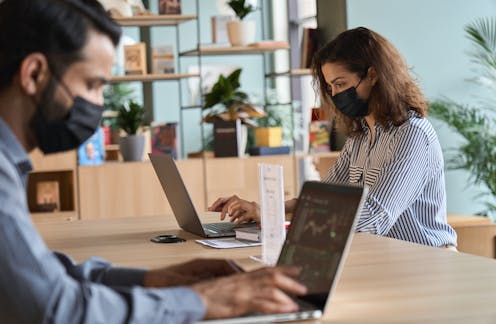We're entering a new phase of COVID, where we each have to assess and mitigate our own risk. But how?
- Written by The Conversation

The Australian government’s latest COVID management plan, released yesterday, maps how the nation will learn to live with COVID. This means transitioning from the emergency phase of the pandemic response, to responding to it in a similar way to other respiratory diseases.
However, as part of this transition, we are still going to need to respond to COVID waves which, although expected to be less destructive, are likely to occur for some time to come.
Under the plan, PCR testing will be prioritised for people who are at greater risk of severe disease from COVID – they will still be able to get a PCR test for free. Others will need a doctor or nurse practitioner referral to access free PCR tests, unless they visit a state or territory-run clinic.
Much of the new plan is based on individuals assessing and mitigating their own COVID risk, with more options available to those who are at greatest risk.
So what are the options going forward to protect yourself from COVID? And how do you assess your own risk?
How can you protect yourself and others from COVID?
The most effective thing all of us can do to decrease the risk of COVID is to be up-to-date with our vaccinations and boosters. COVID vaccines aren’t perfect and don’t completely stop transmission, but they greatly reduce your likelihood of becoming seriously ill.
Under this plan, testing for COVID will move from a surveillance tool, where we aimed to detect most cases, to a targeted testing system aimed to identify those who are eligible for COVID antivirals. However, people at low-risk of severe illness are still encouraged to do a rapid antigen test (RAT) if they have COVID symptoms so they can confirm if they are infected and isolate appropriately.
People who are at higher risk of severe COVID (older Australians, First Nations people, and people with disability, compromised immune systems or complex underlying health conditions) may be eligible for COVID antivirals. These are highly effective in reducing the rate of hospital admission but need to be started within five days of symptoms starting. Antivirals are available to eligible people after either a positive RAT or PCR test.
In addition to the use of vaccines and medicines to reduce COVID risk, we can also reduce the likelihood of spreading COVID by using the strategies we’ve become so familiar with since the start of the pandemic, including masking up, avoiding crowded settings, socialising outdoors where possible and in well-ventilated spaces when indoors, and staying away from others if feeling unwell.
We all have a different tolerance for risk
One of the difficulties we all face is working out how we assess and manage our own risk in a world where COVID is a constant presence.
The SARS-CoV-2 virus poses a much greater risk to certain groups, particularly those who are older and people who have chronic health conditions.
For others, the risk the SARS-CoV-2 virus poses is much lower. However, we still have much to learn about long COVID, so we need to factor this into our considerations.
Read more: Four tips to avoid your office Christmas party turning into a superspreader event
So how do you work out how far to go in protecting yourself and others from COVID?
In addition to our actual risk being different, we all differ in our tolerance to risk, which is determined by our psychological make up as well as social and cultural factors. This impacts our risk-benefit calculations, and our subsequent decisions.
People who face similar risks may experience this risk in very different ways. One person may perceive the risk of contracting COVID as too high to take part in certain social activities. Another may see the risk as acceptable when they weigh it up against the costs of social isolation on other aspects of their health and wellbeing.
One of the things we are all going to have to do is to accept these differences in risk tolerance between people and understand that individual risk-benefit calculations are personal, complex and nuanced.
For some people, getting COVID is a much greater threat
Although for many people, the risk calculus is now at a point where their lives can start to look more normal than they have for some time, for others the sense of vulnerability to COVID remains high.
The government’s plan aims to leave no-one behind and will prioritise care and support for groups at higher risk, including First Nations people, those in aged care, people with disability and culturally and linguistically diverse communities. This includes prioritising vaccination, testing, access to antivirals and targeted outreach programs.
However, based on the bumpy journey we’ve had over the past few years, one would be forgiven for reserving their judgement on how successful these efforts will be.
The biggest difficulty we face in the next 12 months is navigating the reality that not only are some people going to be impacted to a much greater degree than others, we are all going to vary in our risk tolerance. Therefore, it’s important that we respect others’ circumstances in the decisions we make.
Read more: Doing away with COVID isolation rules means increased isolation and risks for people with disability







